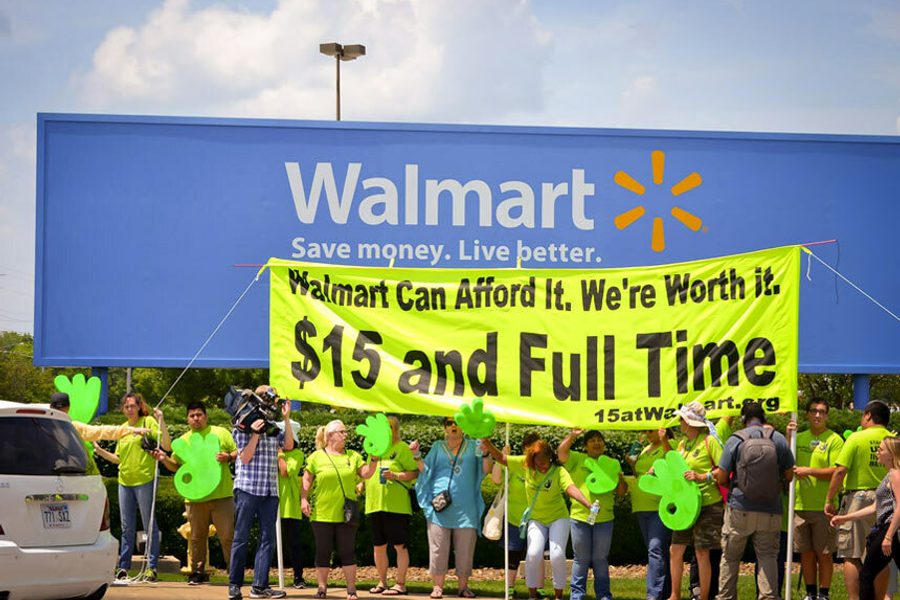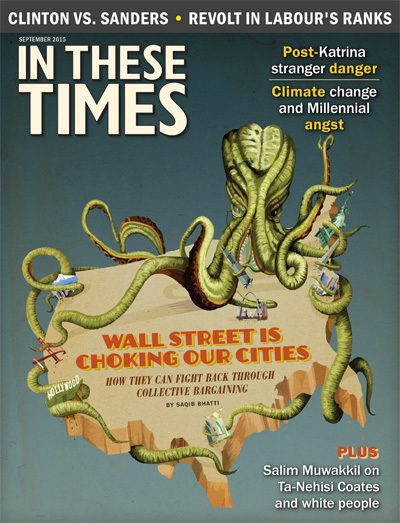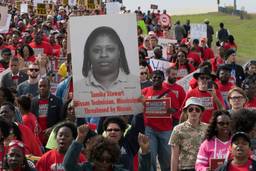The Union Behind the Biggest Campaign Against Walmart in History May Be Throwing in the Towel. Why?
With major cuts rumored, the future of the campaign against America’s largest private employer is uncertain.
David Moberg

In the pre-dawn chill of Black Friday 2012, a half-dozen yellow school buses pulled up at a South Side Chicago Walmart store, disgorging a small group of striking Walmart workers and nearly 250 supporters.
Along with strikers and allies in 100 other cities around the country, they had come out that day under the aegis of the year-old Organization United for Respect at Walmart (OUR Walmart), created to give Walmart workers a vehicle to protest their mistreatment — including low wages, skimpy benefits, erratic scheduling and aggressive management suppression of employees’ voices at work.
“Somewhere, somehow, down the line, it’s going to make a big difference,” said Tyrone Parker, a striking night-shift stocker, at that first Black Friday action.
“If you weren’t excited after some of those Black Fridays, you were dead,” says former United Food and Commercial Workers (UFCW) President Joseph Hansen, who started OUR Walmart and the labor-community coalition Making Change at Walmart in 2005. “It was going to be a long haul, but I thought we had no choice.”
After Hansen’s retirement last fall, the union’s 55-member executive board elected Secretary-Treasurer Anthony “Marc” Perrone as the next president. Leading up to the vote, Perrone had questioned the amount of money that had been devoted to the Walmart campaign without gaining any new members for the union, whose membership has declined in recent years. Several sources close to the campaign, not named because they are not authorized to release financial information, estimate that the overall cost had been about $7 million to $8 million a year.
In April, four months into Perrone’s tenure, the Washington Post reported rumors of potential cutbacks to OUR Walmart. In These Times’s sources say the union plans to cut the campaign’s budget by as much as 65 percent.
Sources close to the new leadership say no cuts are planned, only realignments, such as spending more money on advertising and public relations campaigns to highlight Walmart’s faults. At the same time, UFCW will try to parlay the Walmart efforts into “a broader retail campaign,” according to new Executive Vice President Stuart Appelbaum, regarded as an ally of Perrone. This probably will encourage more organizing at other retailers to win contracts and dues-paying members.
As Buzzfeed reported in June, the union also removed two directors of the Walmart effort, Dan Schlademan and Andrea Dehlendorf, in May. Meanwhile, the board of OUR Walmart — five worker-members and the two directors — has sought and received new funding from two progressive donors, according to the director of a funders’ group to which both belong.
Most key labor leaders, whatever their view of OUR Walmart, are unwilling to talk very much, because they hope to continue to work with UFCW on the Walmart campaigns, if possible.
Although OUR Walmart and the Fight for 15 (the Service Employees International Union-backed fast-food workers’ campaign, which has targeted McDonald’s) have been expensive for the unions, they’ve stoked worker and public fervor against two of the mightiest global corporations.
“The union’s biggest accomplishment is the development of OUR Walmart,” says an ally in the campaign who feels that new spirit may be lost in the reshuffling.
How big is too big?
The UFCW largely ignored Walmart when it was a small-town, Southern five-and-dime chain. But as Walmart moved north and west and into groceries, the union had to challenge the mega-retailer to protect its contracts. A massive array of strategies has been tested, with little success: organizing department by department (when butchers at a Texas store voted for the union, Walmart eliminated all its butchers); organizing in Quebec, where laws favor unions (Walmart closed the store); organizing in strong union towns, like Las Vegas (several campaigns failed after supervisors intimidated a majority of workers out of unionizing).
UFCW has also tried educating the public about the high costs of Walmart’s low prices. In 2005, both SEIU and UFCW began publicity campaigns about the corporation’s misbehavior (called, respectively, Walmart Watch and Wake Up, Walmart). Walmart Watch revealed a 2005 internal company memo on how Walmart might cut its already low pay and benefits without incurring bad publicity by increasing the number of part-time workers. Such well-aimed, sharp darts wounded the company’s reputation and may have been a factor in declining profits, although customers have also faulted Walmart for badly stocked, disorganized stores, unattractive produce and poor service.
But these campaigns did not yield union members. By failing to organize the retail behemoth, which provides 8.9 percent of jobs in the sector (which in turn employs nearly 1 in 9 U.S. workers), unions lost power to set wage and labor standards. Since 1983, the percentage of retail workers who belong to unions has declined by half — to 4.4 percent.
When Schlademan started work at the UFCW in 2010 on what would become the new Walmart strategy, he tried to learn from workers and organizers in past campaigns, as he explained in an interview with In These Times in December. First, he concluded, the campaign had to break down the barriers isolating workers from each other, both within and among stores. Second, Walmart workers wanted to be “front and center” in the campaigns and in solving problems. Third, workers had to discover the power of collective action, primarily through strikes, which Schlademan called “probably one of the most liberating things labor does. Striking — just [the act of] striking — helps build leaders.”
Over the next three years, OUR Walmart’s key achievement was mobilizing workers to take direct action against the company. OUR Walmart members challenged management at both their workplaces and at shareholder meetings in Bentonville, Ark., often with work stoppages, sit-ins or similar protests. In the process, effective and committed rank-and-file leaders emerged.
The campaign also won praise for its effective use of online organizing. Organizers and members used the web to move workers into reallife collective protests, build small groups of leaders at individual stores, and arrange local and national direct actions. The online connections produced more direct, horizontal relationships between Walmart workers than in most unions, which have a more hierarchical organization.
OUR Walmart said the campaign was just trying to make Walmart a better corporate citizen, not organize a union. Technically that was true (and tactically necessary, given labor law restrictions on picketing employers for long periods). But in spirit, OUR Walmart resembled a strong minority union, without enough votes to win a formal union and collective bargaining, but with other tools that could be used to solve workers’ problems.
The campaign wrung several concessions from Walmart. Workers won a few pilot programs to reduce inconsiderate scheduling, and a worker-led campaign to “Respect the Bump” yielded better pregnancy accommodations. Accompanied by publicity campaigns attacking the company’s stinginess and its owners’ extreme wealth, worker actions undoubtedly helped prompt Walmart’s decision in April to raise its lowest wages to $9 an hour this year and $10 next year.
Hopes for transforming Walmart — and thereby the whole low-wage economy — rose among supporters.
OUR Walmart is “a little IWW-ish,” Schlademan said in December. In their early 20th-century heyday, the Industrial Workers of the World eschewed contracts in favor of direct action at work. In OUR Walmart, Schlademan sees a similar appetite for militant action and a more vigorous involvement in the collective, horizontal conversation.
At the time, Schlademan said, OUR Walmart was preoccupied with securing its right to exist without being attacked all the time: “Walmart must realize OUR Walmart is not going away.”
But sustaining an expensive campaign like OUR Walmart is difficult with voluntary dues of $5 a month per member. Schlademan has since been cut from the UFCW payroll but is still working with OUR Walmart. And rumors of UFCW withdrawing funds have begun circulating, although a network of progressive donors recently pledged money for OUR Walmart to maintain its work.
If UFCW, the organization’s sponsor, cuts back on OUR Walmart, how will managers — and workers — interpret the move?
Critics of the union’s focus on OUR Walmart believe that broadening the agenda to all retail will spread around organizing dollars more effectively, yielding more unionized shops and more dues-paying members. No organizing is easy, but looking beyond Walmart may provide more realistic targets. In New York — the historic stronghold of the Retail, Wholesale and Department Store Union (now a department within UFCW) — UFCW Vice President and RWDSU President Stuart Appelbaum has overseen successful organizing of clothing boutique workers, such as clerks at the Swedish-owned “cheap chic” H&M stores.
Victory at such companies will bring new members but will not necessarily transform the retail industry the way success at a major chain like Walmart or Home Depot could.
The union will almost certainly maintain some special focus on Walmart. “Nobody wants to walk away from or abandon effort on Walmart,” says one union staffer, who was not authorized to speak with reporters. But the union’s Walmart project “will be a more media-focused campaign,” relying on print and television ads, says the staffer.
Media buys can be very expensive, however. Forbes reported that UFCW “spent six figures” on a Fourth of July ad blitz portraying Walmart as unpatriotic for stashing $76 billion in 15 foreign tax havens. And if past attacks haven’t altered Walmart’s stance on unions, will more exposés do the trick?
On the other hand, the sweeping victories of the 1930s and 1960s in industries from automobiles to healthcare suggest the value of a sector-wide strategy for retail. But can one union take on a sector with 16 million workers?
It starts with the workers
Stephen Lerner is the architect of SEIU’s Justice for Janitors campaign, one of the most successful sector-wide organizing efforts of the past three decades. He argues that, with labor hanging by a thread, most U.S. unions have gone into defense mode — which only occasionally delays further slippage — rather than playing offense using creative, large-scale campaigns.
Though most analysts see the evershifting Walmart campaign as a defensive effort to keep Walmart from driving down labor standards at other, unionized grocery chains, Lerner believes OUR Walmart is an example of a sweeping, innovative effort. “It’s pretty impressive what workers in OUR Walmart have achieved so far,” he says. He notes that strikes have yielded concrete victories and that creative online organizing has allowed workers to help move people into action, not simply to “scream into the void.”
For workers to form a union against the will of an industry or a big company like Walmart requires “an enormous amount of time” to understand the issues, overcome fears, develop leaders, and formulate a “theory of how to beat the company,” which may vary from target to target, Lerner says. Justice for Janitors’ big breakthrough, in a 1988 organizing campaign in Denver, came in part from understanding that targeting building owners, for whom janitorial costs are minuscule, was essential to organizing the small, costsensitive cleaning companies. “There’s not one tactic or secret sauce to take on an entire industry,” he says.
As UFCW revises or expands its organizing mission, it would seem smart to look for ways to apply the strategy and style of work of OUR Walmart — that is, educating and empowering member-organizers and leaders — throughout its retail organizing. That includes recognizing the utility of the internet for real organizing, breaking barriers and building solidarity and expanding open, direct, horizontal lines of communication among members and workplace leaders. It also includes realizing the crucial role of strikes and direct action in building a sense of collective power and communicating with supporters and the public.
OUR Walmart member Tyfani Faulkner, 32, a high school graduate from Sacramento who knew nothing about the labor movement when she took her job, now loves going online to answer questions or solve others’ problems, or to work for legislation or a candidate she favors (most recently, Bernie Sanders). Her “proudest moment,” she says, was participating in a two-hour sit-in at Walmart this past November. OUR Walmart has produced many powerful worker-leaders and vocal progressives like Faulkner who organize effectively — and at no cost.
The emergence of leaders like Faulkner reinforces the urgency of taking seriously Lerner’s key advice, which is as simple as it is often ignored: “You can’t win without the workers.”

I hope you found this article important. Before you leave, I want to ask you to consider supporting our work with a donation. In These Times needs readers like you to help sustain our mission. We don’t depend on—or want—corporate advertising or deep-pocketed billionaires to fund our journalism. We’re supported by you, the reader, so we can focus on covering the issues that matter most to the progressive movement without fear or compromise.
Our work isn’t hidden behind a paywall because of people like you who support our journalism. We want to keep it that way. If you value the work we do and the movements we cover, please consider donating to In These Times.
David Moberg, a former senior editor of In These Times, was on staff with the magazine from when it began publishing in 1976 until his passing in July 2022. Before joining In These Times, he completed his work for a Ph.D. in anthropology at the University of Chicago and worked for Newsweek. He received fellowships from the John D. and Catherine T. MacArthur Foundation and the Nation Institute for research on the new global economy.








